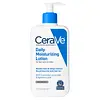What's inside
What's inside
 Key Ingredients
Key Ingredients

 Benefits
Benefits

 Concerns
Concerns

 Ingredients Side-by-side
Ingredients Side-by-side

Water
Skin ConditioningGlycerin
HumectantCaprylic/Capric Triglyceride
MaskingCetearyl Alcohol
EmollientCetyl Alcohol
EmollientPotassium Phosphate
BufferingCeramide NP
Skin ConditioningCeramide AP
Skin ConditioningCeramide EOP
Skin ConditioningCarbomer
Emulsion StabilisingDimethicone
EmollientCeteareth-20
CleansingBehentrimonium Methosulfate
Methylparaben
PreservativeSodium Lauroyl Lactylate
EmulsifyingCholesterol
EmollientDisodium EDTA
Dipotassium Phosphate
BufferingPropylparaben
PreservativeHydrolyzed Hyaluronic Acid
HumectantPhytosphingosine
Skin ConditioningXanthan Gum
EmulsifyingPolysorbate 20
EmulsifyingPolyglyceryl-3 Diisostearate
EmulsifyingWater, Glycerin, Caprylic/Capric Triglyceride, Cetearyl Alcohol, Cetyl Alcohol, Potassium Phosphate, Ceramide NP, Ceramide AP, Ceramide EOP, Carbomer, Dimethicone, Ceteareth-20, Behentrimonium Methosulfate, Methylparaben, Sodium Lauroyl Lactylate, Cholesterol, Disodium EDTA, Dipotassium Phosphate, Propylparaben, Hydrolyzed Hyaluronic Acid, Phytosphingosine, Xanthan Gum, Polysorbate 20, Polyglyceryl-3 Diisostearate
Water
Skin ConditioningCyclopentasiloxane
EmollientDimethicone Crosspolymer
Emulsion StabilisingGlycerin
HumectantHdi/Trimethylol Hexyllactone Crosspolymer
Butylene Glycol
HumectantOctyldodecanol
EmollientDihydroxyisopropyl Capryloylcaprylamide
Skin ProtectingNiacinamide
SmoothingPolysorbate 80
EmulsifyingSodium Hyaluronate
HumectantSodium Polyacrylate
AbsorbentTocopheryl Acetate
AntioxidantPortulaca Oleracea Extract
Skin ConditioningCrithmum Maritimum Extract
Skin ConditioningGlycyrrhiza Glabra Root Extract
BleachingCamellia Sinensis Leaf Extract
AntimicrobialPoria Cocos Extract
Skin ConditioningVitis Vinifera Seed Oil
EmollientCamellia Sinensis Seed Oil
HumectantLimnanthes Alba Seed Oil
Skin ConditioningHydrogenated Vegetable Oil
EmollientSorbitan Olivate
EmulsifyingSucrose Cocoate
EmulsifyingCaprylyl Glycol
EmollientBisabolol
MaskingDimethicone
EmollientCetyl Palmitate
EmollientSorbitan Palmitate
EmulsifyingSerine
MaskingPhytosterols
Skin ConditioningAlanine
MaskingGlycine
BufferingTrideceth-6
EmulsifyingCaprylic/Capric Triglyceride
MaskingSodium Carboxymethyl Beta-Glucan
CleansingMyristoyl/Palmitoyl Oxostearamide/Arachamide Mea
Skin ConditioningBiotinoyl Hexapeptide-2 Amide
Skin ConditioningAmmonium Acryloyldimethyltaurate/Vp Copolymer
PEG/PPG-18/18 Dimethicone
EmulsifyingXanthan Gum
EmulsifyingSilica
AbrasiveGlyceryl Stearate
EmollientSorbitan Stearate
EmulsifyingPhenoxyethanol
PreservativePolyvinyl Alcohol
Cetearyl Alcohol
EmollientStearic Acid
CleansingCitric Acid
BufferingParfum
MaskingWater, Cyclopentasiloxane, Dimethicone Crosspolymer, Glycerin, Hdi/Trimethylol Hexyllactone Crosspolymer, Butylene Glycol, Octyldodecanol, Dihydroxyisopropyl Capryloylcaprylamide, Niacinamide, Polysorbate 80, Sodium Hyaluronate, Sodium Polyacrylate, Tocopheryl Acetate, Portulaca Oleracea Extract, Crithmum Maritimum Extract, Glycyrrhiza Glabra Root Extract, Camellia Sinensis Leaf Extract, Poria Cocos Extract, Vitis Vinifera Seed Oil, Camellia Sinensis Seed Oil, Limnanthes Alba Seed Oil, Hydrogenated Vegetable Oil, Sorbitan Olivate, Sucrose Cocoate, Caprylyl Glycol, Bisabolol, Dimethicone, Cetyl Palmitate, Sorbitan Palmitate, Serine, Phytosterols, Alanine, Glycine, Trideceth-6, Caprylic/Capric Triglyceride, Sodium Carboxymethyl Beta-Glucan, Myristoyl/Palmitoyl Oxostearamide/Arachamide Mea, Biotinoyl Hexapeptide-2 Amide, Ammonium Acryloyldimethyltaurate/Vp Copolymer, PEG/PPG-18/18 Dimethicone, Xanthan Gum, Silica, Glyceryl Stearate, Sorbitan Stearate, Phenoxyethanol, Polyvinyl Alcohol, Cetearyl Alcohol, Stearic Acid, Citric Acid, Parfum
 Reviews
Reviews

Ingredients Explained
These ingredients are found in both products.
Ingredients higher up in an ingredient list are typically present in a larger amount.
This ingredient is an emollient, solvent, and texture enhancer. It is considered a skin-softener by helping the skin prevent moisture loss.
It helps thicken a product's formula and makes it easier to spread by dissolving clumping compounds.
Caprylic Triglyceride is made by combining glycerin with coconut oil, forming a clear liquid.
While there is an assumption Caprylic Triglyceride can clog pores due to it being derived from coconut oil, there is no research supporting this.
Learn more about Caprylic/Capric TriglycerideCetearyl alcohol is a mixture of two fatty alcohols: cetyl alcohol and stearyl alcohol. It is mainly used as an emulsifier. Emulsifiers help prevent the separation of oils and products. Due to its composition, it can also be used to thicken a product or help create foam.
Cetearyl alcohol is an emollient. Emollients help soothe and hydrate the skin by trapping moisture.
Studies show Cetearyl alcohol is non-toxic and non-irritating. The FDA allows products labeled "alcohol-free" to have fatty alcohols.
This ingredient is usually derived from plant oils such as palm, vegetable, or coconut oils. There is debate on whether this ingredient will cause acne.
Due to the fatty acid base, this ingredient may not be Malassezia folliculitis safe.
Learn more about Cetearyl AlcoholDimethicone is a type of synthetic silicone created from natural materials such as quartz.
What it does:
Dimethicone comes in different viscosities:
Depending on the viscosity, dimethicone has different properties.
Ingredients lists don't always show which type is used, so we recommend reaching out to the brand if you have questions about the viscosity.
This ingredient is unlikely to cause irritation because it does not get absorbed into skin. However, people with silicone allergies should be careful about using this ingredient.
Note: Dimethicone may contribute to pilling. This is because it is not oil or water soluble, so pilling may occur when layered with products. When mixed with heavy oils in a formula, the outcome is also quite greasy.
Learn more about DimethiconeGlycerin is already naturally found in your skin. It helps moisturize and protect your skin.
A study from 2016 found glycerin to be more effective as a humectant than AHAs and hyaluronic acid.
As a humectant, it helps the skin stay hydrated by pulling moisture to your skin. The low molecular weight of glycerin allows it to pull moisture into the deeper layers of your skin.
Hydrated skin improves your skin barrier; Your skin barrier helps protect against irritants and bacteria.
Glycerin has also been found to have antimicrobial and antiviral properties. Due to these properties, glycerin is often used in wound and burn treatments.
In cosmetics, glycerin is usually derived from plants such as soybean or palm. However, it can also be sourced from animals, such as tallow or animal fat.
This ingredient is organic, colorless, odorless, and non-toxic.
Glycerin is the name for this ingredient in American English. British English uses Glycerol/Glycerine.
Learn more about GlycerinWater. It's the most common cosmetic ingredient of all. You'll usually see it at the top of ingredient lists, meaning that it makes up the largest part of the product.
So why is it so popular? Water most often acts as a solvent - this means that it helps dissolve other ingredients into the formulation.
You'll also recognize water as that liquid we all need to stay alive. If you see this, drink a glass of water. Stay hydrated!
Learn more about WaterXanthan gum is used as a stabilizer and thickener within cosmetic products. It helps give products a sticky, thick feeling - preventing them from being too runny.
On the technical side of things, xanthan gum is a polysaccharide - a combination consisting of multiple sugar molecules bonded together.
Xanthan gum is a pretty common and great ingredient. It is a natural, non-toxic, non-irritating ingredient that is also commonly used in food products.
Learn more about Xanthan Gum